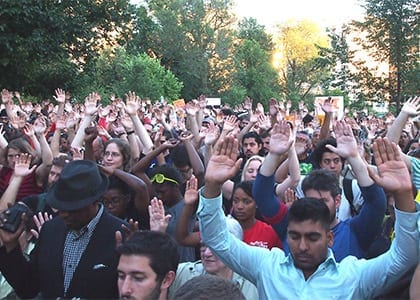
The Ferguson, Mo., police shooting of Michael Brown has sparked national discussions of race, the militarization of local police departments, racially-segregated housing patterns, the vilification of black males in the media and other issues that underscore vast differences between the experiences and perceptions of blacks and whites in the United States.
The shooting itself boils down to an everyday occurrence: A confrontation between a teenager and a cop.
For whites, the outcomes of such confrontations are often radically different than those for blacks. In Ferguson, blacks interviewed by the media say the police force, with just 3 blacks among its 53 officers, often subjects them to beatings, arbitrary arrests and harassment.
While whites in Ferguson have not been as widely interviewed by media on their experiences of police brutality, the arrest statistics the department turned over to Missouri’s attorney general tell the story: In a town that’s 67 percent black, blacks account for 86 percent of all traffic stops, 92 percent of searches and 93 percent of arrests — this in spite of the fact that 22 percent of blacks arrested were found to have contraband as opposed to 34 percent of whites.
The racial discrepancies in policing in Ferguson mirror a wider divide between the way blacks and whites in the United States perceive the events that led to Brown’s killing and the aftermath of the killing.
Police initially alleged that Brown tried to wrest a service weapon away from officer Darren Wilson, who is white, before Wilson shot him. Two eye witnesses told reporters Brown had his hands in the air in the universal gesture denoting surrender when Williams opened fire, striking Brown more than six times; twice in the head.
In the days that followed, through the rioting, the tear gassing of black Ferguson residents, protesters, reporters and bystanders, the rubber bullets, a curfew and a police response that has been widely panned in the national media, the story of what happened that day continued to unfold.
When, after days of stalling, Ferguson Police Chief Tom Jackson released Wilson’s name, he also released video footage from a store security camera showing a black man alleged to be Brown being confronted by a store owner. While Jackson said the video depicts Brown stealing cigars from the store, a lawyer for the store owner said the owner did not know or identify the man in the video and did not call police to report a robbery.
Police later admitted that Brown was not suspected of robbery or any other crime when he was stopped by Wilson. But the message of the release of the video was clear: Ferguson Police were linking Brown’s alleged criminal activity to his death, much in the same way lawyers for George Zimmerman sought to link Trayvon Martin’s past use of marijuana to a criminal mindset.
In so doing, the Ferguson Police were tapping into a deeper narrative about race and crime in American society. While 80 percent of blacks contacted by pollsters from the Pew Research Center said the Ferguson shooting raises important issues about race, just 37 percent of whites agreed with that statement and 47 percent of whites agreed that the issue or race is getting more attention than it deserves.
The images of Ferguson and St. Louis County police dressed in military fatigues with body armor perched on top of armored vehicles and training high-powered assault rifles at unarmed protesters drew a mixed response from whites, with 33 percent saying the police response had gone too far, 30 percent saying the police response has been “about right” and 35 percent undecided.
The majority of blacks — 65 percent — said the police response had gone too far, while 20 percent of blacks said it was “about right.”
As if the militarized police, clouds of tear gas, stun grenades and rifles trained on unarmed black protesters and passers-by weren’t enough, a CNN broadcast captured one officer on video taunting the protesters: “f—ing animals. Bring it. I don’t give a f—.”
In a spectacle that stood in stark contrast to the black experience, white residents of Ferguson held a protest of their own, holding signs expressing solidarity with Darren Wilson, who has been suspended with pay and in hiding during the unrest. A crowd estimated at 150 turned out for the demonstration. Many wore teeshirts with a police shield with the words, “I stand by Darren Wilson.” In place of the badge number are the numbers 8.9.14 — the date Wilson gunned Brown down.
As wide as the chasm appears between black and white Ferguson — and black and white America — it’s worth noting the instances of solidarity that bridge that gap. Here in Boston, solidarity rallies on the Boston Common and in Copley Square were mixed-race events with blacks, whites, Latinos and Asians denouncing police violence against black men.
That same solidarity was reflected in rallies held in more than 90 cities across the United States, and in cities around the world — including London, UK, and Sydney, Australia. In Gaza, Palestinians used Twitter to express solidarity and share advice on how to survive tear gas attacks.
As the protests over Brown’s shooting entered their 10th day Monday night, Ferguson residents suffered through more tear gas and stun grenades, rubber bullets and live ammunition. And the divide between accounts provided by Ferguson residents and the police remained as wide as ever, with police accusing the protesters of pelting them with Molotov cocktails and stones and the protesters claiming they were fired on without provocation.







